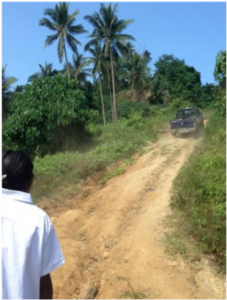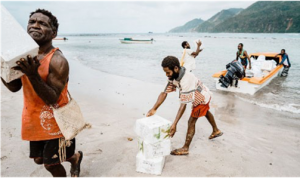
SUPPLY CHAIN IN THE REAL WORLD: HOW UMSL LEADERS ARE ADDRESSING GLOBAL HEALTH ISSUES
By: Maya Harter
Vaccines save millions of lives around the globe, but are not currently readily accessible in parts of less developed countries. This devastating issue sparked the interest of three professors of UMSL’s Supply Chain Department: Dr. Shakiba Enayati, Dr. Haitao Li, and Dr. James Campbell. This project gave the researchers an opportunity to apply their expertise not just to help a company or organization run their operations better, but to save the lives of children.
Dr. Campbell, who has a background in modeling and optimization for transportation and supply chain systems, describes the beginnings of the project as a collective interest over time as the issue became more prevalent.
“I think all of us are intellectually curious people who read and observe what is going on in the world of logistics and supply chain, and when you see something new, we kind of say wow, how can we use our skills.”
The team has diverse backgrounds with specialties that have enabled them to apply academic knowledge to a complex, real-world problem. Dr. Shakiba Enayati specializes in mathematical modeling and optimization of complex systems as applied to healthcare, service, and supply chain systems.
Dr. Haitao Li has specialty in optimization modeling and algorithm design in the broad area of supply chain optimization including network design, scheduling, routing, and resource allocation.
Dr. Campbell learned of a project in Vanuatu in 2018, with funding from UNICEF to deliver vaccines by drone to the islands.
“The sort of problem we’re looking at is a huge challenge. Specifically in Vanuatu, it’s a nation of 63 islands scattered across 1300 kilometers of the South Pacific. It’s this very big area that you’re trying to transport vaccines across, plus you’ve got a time limit on how long that vaccine is viable. You have very rudimentary transportation networks and very small villages that are hard to reach. And that’s where the drones come in.”
A child’s first year of life requires a series of vaccines to prevent common diseases, making this a crucial time to set up children for a healthy life. The research is mainly focused on vaccines for traditional childhood diseases, measles, mumps, rubella, whopping cough, etc. These illnesses not only can lead to death in children, but have a massive effect on families and communities. While this was the focus of this research at the start of 2018, this model could also be applied to aiding relief in future pandemics.
Drones offer a great alternative to traditional modes of transport, as they travel fast and can reach rural and remote areas. While drones have limitations on carrying capacity, this is less an issue with vaccines as they are very small doses.
The team has been conducting research under a 3-year grant from the Association of Supply Chain Management (ASCM) since 2019. They have developed an optimization model to come up with an innovative way to design the vaccine distribution network for less developed countries. This enabled them to recommend the best location and distribution network based on the optimization model. The main objective of the models is to minimize transportation costs while considering limitations such as drone range and vaccine cold chain requirements.
According to Dr. Campbell, they didn’t appreciate just how complex the problem was until they started to get into the math and modeling. They realized that not only does this issue involve important policy issues, but also very high-level modeling and optimization problems.
“I think the biggest surprise to us has been how challenging the transportation and logistics problems are; it turned out to be much harder than we initially thought. And that makes it academically interesting”
The issue is that we have vaccines that can prevent a vast number of diseases, but we can’t get the vaccines to the children. This is a logistical problem, which is why the team has been able to apply their supply chain expertise to approach this problem.
“There’s many people trying to solve global health problems – but they aren’t experts in optimization and modeling. We’re not experts in global health, so we hope to share our expertise with the global health community to address the problem”. (JC)
Dr. Li has seen that this exposes even more potential for collaboration in logistics and other fields to tackle these real-world issues in a way that other experts aren’t able to. “I feel there’s still a disconnection between practice and academic research in this arena. So, there’s a need to mitigate the gap.”
When Amazon proposed using drones as opposed to trucks for delivery, this was a new and exciting innovation. We never would have imagined that drones could be used to save lives around the world, and now there are many possibilities for application to other transportation issues.
The exciting thing about these mathematical models is that they have vast potential for other applications. With its ability to consider multiple dimensions of characteristics of problems, they can be applied to many complex real-world logistical problems.
You can learn more about the research at their website.
Learn more about our award-winning M.S in Supply Chain analytics program.




